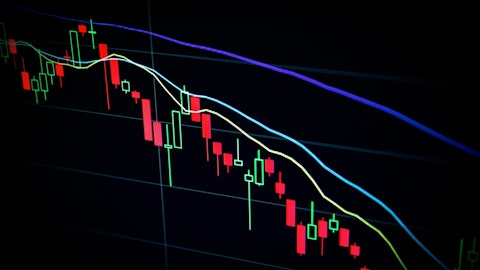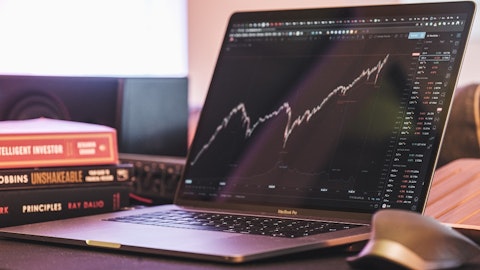Filippo Falorni: A question on the Asia Pacific business. James, you mentioned that the India business was very solid but China was weak. First, maybe you can give a comment on how big of a drag China was in the quarter and what are your expectations going forward into next year? And then from a price/mix standpoint, price/mix of one in the segment was one of the lowest across your other segments. I know there’s probably some geographic mix impact. But can you talk about the pricing environment as well in Asia Pacific?
James Quincey: Sure. Yes. I mean, China was clearly a drag in volumetric terms on the segment. Most importantly, from a margin point of view, it’s really important to not over-rotate to the numbers in any given quarter, given the lumpiness of — this is concentrate sales, several steps back in the supply chain from the consumer. So I think it’s important to always take an average of four quarters. In the third quarter, as I commented a little earlier, we made a number of decisions on portfolio prioritization as it related to China and to investing for a fast start in 2024 in a number of markets in Asia Pacific, whether that be Japan or China. And so there are some investments going there. The overall pricing environment is relatively clear.
China inflation is relatively minimal. In Japan, we’ve been taking pricing recently, given the inflation in Japan which is kind of very different to the last 30 years. And then the rest of the inflation is kind of the relatively obvious CPI around the rest of ASEAN and Australia. And so that’s really what’s driving it. I think see the third quarter in Asia Pacific more as an anomaly in terms of price/mix rather than a trend.
Operator: Our next question comes from Carlos Laboy from HSBC.
Carlos Laboy: Can you speak to the sort of digital investments that the U.S. bottlers are doing and that you’re helping them with? Is it more revenue-driven or perhaps more efficiency cost supply chain-centric? I guess in sum, what I’m trying to understand is how are digital investments changing these U.S. bottlers and their capabilities?
James Quincey: What was the last bit of the question, Carlos?
Carlos Laboy: How are these digital investments changing these bottlers and their capabilities?
James Quincey: Sure. I mean the U.S. bottler is much like the rest of the international bottlers are undergoing a set of digital investments. And actually, it’s both. The answer is not either, it’s both. We have been making investments in technology for a long period of time to drive efficiencies through the supply chain, through the manufacturing, through the logistics whether it be old-school technology investments, AI and now generative AIs are kind of a different feature. So there’s a lot going on and there’s a lot of connectivity among the bottlers on the enterprise software side because they’re all connected through — they’re basically all use or most of them use a shared platform to get things done that’s referred to internally as CONA.
So there’s a lot of investment on making sure the supply chain is as efficient as it can be and a lot of support from ecosystem partners to get it done. And then in terms of the rest of the — I mean, they’re investing in the marketplace that digitize the relationship with largely the non-modern trade. Obviously, when you’re talking to the big modern retail customers, that interaction is already largely digitized. And the focus there is on trying to intensify the connection, really from a supply chain, inventory visibility and forecasting effectiveness point of view but the connectivity already exists. And then from the non-chain customers, it’s really about can you get them on to — in simple terms, a B2B platform so that it’s 24/7 opportunities to order, knowing that if you can digitize the relationship, then it tends to be deeper and more productive.
And then once that exists, layering on an AI component which a number of the bottlers internationally have been working on in coordination, an AI-supported kind of B2B relationship over a platform that can then provide them suggested purchase orders. And that is also helping to drive the business. So the U.S. bottlers in that sense are very much on a similar journey to the international bottlers.
Operator: Our last question will come from Brett Cooper from Consumer Edge.
Brett Cooper: Not necessarily looking at the third quarter or year-to-date results but looking over many years, Coke’s growth in sparkling and non-sparkling hasn’t been meaningfully different, whereas there would seem to be a higher growth opportunity in non-sparkling given just the differential in market share that you hold and the implementation of category cluster management. So can you speak to any impediment to higher growth in non-sparkling or what I’m likely missing? And then, I guess the part B is just within that umbrella, can you talk about your ability to develop newer categories to the company like hot coffee or alcohol?
James Quincey: Sure. We — our objective is to do justice for the brands in the portfolio. And certainly, you can make an argument that those categories where we have lower shares have a natural opportunity to gain share. But of course, that is something you need to take from someone else. The other way of seeing the world is to say that the beverage industry seen from a global perspective are referenced back to the page in CAGNY with all the little people on it, the vast majority of the page is actually white space. In other words, the beverage industry is not yet created. And so actually, the idea that sparkling continues to grow is a representation of us operating from a position of strength to create the industry in the white spaces with our most successful and strongest brands.
And so continued growth of sparkling should be a feature of our path going forward. And then in the non-sparkling categories, of course, we are looking to gain share. We talked historically about trying to get from experimental to challengers to leader to quality leadership. And I think that is a long-term build that has been playing out. If you take the long-term perspective and look at the percent of the total business that is made up of non-sparkling brands, it has increased slowly but it has increased consistently over the last couple of decades. So we start from a point of view of being consumer-centric from resource and capital allocation and from earning the right to move up the experimenters into the challenger into the leadership position.
Nothing radical is going to happen overnight. But it is a dynamic that has built steadily over the last number of years and decades. And we’re confident in the opportunity to rebuild the industry or to build the industry further into the future. Okay. That was the last question, operator. Okay. So to conclude, thanks very much, everyone. We’ve proven, I hope you can see, in Q3 that we continue to deliver volume, top line growth and incremental U.S. dollar earnings per share by executing against our all-weather strategy. And we’re confident that we can create value over the long term. So thank you for your interest and your investment in the company and for joining us this morning.
Operator: Ladies and gentlemen, this concludes today’s conference call. Thank you for participating. You may now disconnect.
Follow Coca Cola Co (NYSE:KO)
Follow Coca Cola Co (NYSE:KO)
Receive real-time insider trading and news alerts





